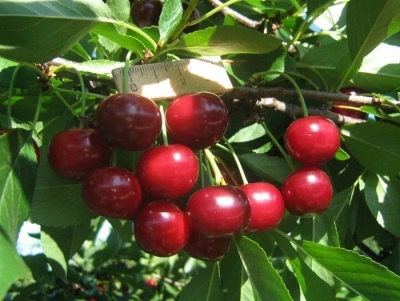
- Barrel type: bush
- Growth type: medium-sized
- Crown: wide, dense, spherical
- Fruit size: large
- Fruit shape: rounded, flattened
- Fruit color: dark red
- Fruit weight, g: 10
- Pulp color : red tint
- Pulp (consistency): tender and juicy
- Separability of the bone from the pulp: good
Variety Vstrecha is a high-yielding cherry for cultivation in the steppe zone. This is a crop loved by many gardeners with very tasty large berries. They make jams, compotes, preserves, marshmallows, freeze them, make candied fruits, and wine. Suitable for private gardens and industrial cultivation.
Breeding history
The variety was created in 1966 at the Institute of Irrigated Horticulture. Sidorenko in Ukraine by agronomists Nikolai and Valentina Turovtsevs. It appeared with the participation of the hybrid form Kievskaya 19, obtained from cherries and sweet cherries, and the late variety Lyubskaya.
Description of the variety
The shrub-type tree grows up to 2.5 m. The bush is spherical, dense and wide. Branches droop during fruiting. The leaves are elongated, elliptical, large, bright green with small notches along the edge, pointed at the end. Flowering occurs in April-May. Flowers are white small, collected in inflorescences of 2-3 pcs. With temperature changes, flowers and ovaries may fall off. The life span of a plant is 20 years.
Fruit characteristics
The berries are large: weighing 9-15 g, round, flattened on top, dark cherry, ruby flesh, juicy and soft, shiny skin is not thick, the stone is small, well separable. They are distinguished by good transportability.
Taste qualities
The taste is great, sweet, with cherry notes. The sugar content is 11.6%. Tasting score: 5 points.
Ripening and fruiting
A young tree begins to bear fruit for 3 years, and then regularly every season. Mid-season in terms of ripening, the berries begin to ripen at the end of June. Not prone to shedding.

Yield
An average of 25 kg is removed from one bush.
Growing regions
The variety is planted in Western Siberia, the North Caucasus, Kalmykia, Krasnodar Territory, Volgograd, Orenburg and Astrakhan regions.
Self-fertility and the need for pollinators
The variety is referred to as partially self-fertile: for setting a large number of berries, Lyubskaya, Perceptible, Samsonovka, Shalunya or Valery Chkalov cherries are planted nearby.
Landing
Young plants are planted from the second half of September to early October, so that they have time to take root before the cold weather begins. Planting is permissible in mid-April - early May, after the ground warms up. The place is chosen sunny, protected from blowing, on a hill. Lowlands and wetlands are not suitable. Nearby can grow: cherry, plum or cherry plum, grapes, elderberry, hawthorn, honeysuckle, mountain ash. Do not plant next to gooseberries, sea buckthorn, raspberries, currants. Tall trees - apple, pear, apricot, linden, maple - should be at a distance of 3-4 m. Culture is contraindicated in proximity to nightshade. Other crops should be placed at a distance of 150-200 cm.
Two-year-old seedlings are suitable for planting. Planting holes are made 60x60 cm in size and left for a month for soil shrinkage. Good drainage is imperative. A mixture of fertile soil, 50 g of superphosphate, 30 g of potassium sulfate, 1 kg of wood ash are poured onto the bottom. After disembarkation, watered with 2 buckets of water.In the absence of rain, water it 2-3 times a week. Saplings are easily adaptable and take root in new conditions. For the winter, they are fenced off with a metal mesh from rodents.


Growing and care
The culture is unpretentious. The tree is recommended to be watered during the flowering and fruiting periods. Over the summer, they irrigate 3-5 times: about a bucket of water is poured under a young bush, 4 buckets under an adult. Watering is combined with top dressing. In the spring, add mullein solution and ammonium nitrate, after flowering - potassium-phosphorus additives, wood ash or urea. In the fall, water-charging irrigation is carried out - 10 buckets of water, 2 buckets of humus or compost are brought under each bush.
The plant needs pruning in the spring: 5-10 of the strongest shoots should remain on the bush, all damaged and diseased ones are removed.


Disease and pest resistance
This is a moderately resistant variety: it is slightly affected by moniliosis and coccomycosis, it can get sick with anthracnose. Every year it is necessary to carry out preventive treatments, especially on wet days: remove broken branches, remove dry foliage, dig up the soil, treat with fungicides.
Pests can attack: aphids, weevils, sawflies. For prevention, it is recommended to regularly dig up the soil and carry out processing.
Requirements for soil and climatic conditions
The species tolerates frosts down to -25 degrees. For protection from frost and wind, trees are recommended to be wrapped with agrofibre, especially young ones. Before the onset of cold weather, the bush is huddled, and the soil around is mulched with a thick layer of humus. The tree is drought-resistant and shade-tolerant, but with a sharp temperature drop, it begins to shed its leaves.
The soil prefers loamy or sandy loam, loose, with neutral acidity. Does not like heavy clay substrates, acidic soils, close occurrence of groundwater is contraindicated. It tolerates poor soils well.
Grown in temperate continental climates with cold snowy winters and hot dry summers. In central Russia, the summer is too damp and cool, which is why the tree develops slowly and does not bring crops.

Review overview
Gardeners speak positively of the Vstrecha variety: it has a high yield, and the fruits are very large, and minimal care is required. Unfortunately, by itself, it does not bear fruit very well, but when planted next to other berry trees, it brings a large harvest. These cherries taste more like sweet cherries.































































